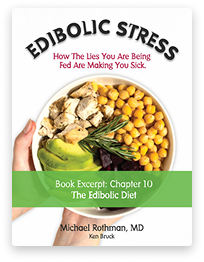Metabolism has Two Parts: Catabolic and Anabolic – Anabolic (builds up) Catabolic (Breaks down)
Your metabolism has two parts (phases), the catabolic phase and anabolic phase. Catabolic means “to break down” (hence the prefix “cata” is found in words like catastrophe, cataclysmic), whereas, anabolic means “to build up” (like anabolic steroids that are used/abused by athletes to build muscle mass)
We are constantly breaking things down and building things up in our bodies. If you were to eat something (a sandwich for example), first you would chew the sandwich (break it down) then the saliva in your mouth, which contains amylases, proteases and lipases (enzymes that break things down) continues this process. Then the sandwich (what is left of it) would enter your stomach and get broken down further by the stomach acids it would encounter.
Then the food enters the small intestine, where it is absorbed, and impurities are filtered out. The remaining nutritive components are redirected back into the blood stream where they are used to create new cells, and connective tissue (building up phase).
Actually, we need not eat for this process to occur. We are constantly breaking things down in our bodies (excessive connective tissue, scar tissue, old cells, cancer cells…) and constantly building new cells and tissues.
We tend to be catabolic during the day (we break down food, fat stores, glycogen stores to create energy) and anabolic at night (we heal wounds, restore energy and grow as we sleep).
In fact, one of the most important factors in our vitality is our ability to cycle through the catabolic phase in the day and the anabolic phase at night.
Young children are a good example of persons that have this type of vitality. Children have incredible energy during the day. They can move for hours and hours and rarely stop to rest. Yet, when night falls they can sleep for 8 or 10 or 14 hours in a row, without interruption. They sleep “like a baby”.
As we age we unfortunately lose this large difference (amplitude) between our catabolic and anabolic phases. We tend to have less energy during the day and sleep less deeply and restoratively at night. Some older, less vital people are almost in a “twilight zone” of little vitality and little rest.
Dr. Emanuel Revici discovered that some people can become imbalanced and get “stuck” in one phase or the other. In other words, they have trouble cycling through both the anabolic and catabolic phases. He was able to measure their anabolic/catabolic balance by using a device called a tensiometer.

Start your journey to true well-being:
A person who has an overly anabolic tendency may experience fatigue (a sleepy fatigue), constipation, depression and hypersomnolence (overly sleepy). They may tend to urinate frequently, especially at night. Often times they will awaken at 4 AM and have trouble sleeping until the morning. These people are prone to high blood pressure and osteoarthritis. Many overly anabolic patients drink coffee on a daily basis (trying to overcome their sleepiness), but in the long run the coffee will make their imbalance much worse.
A person with an overly catabolic tendency may experience fatigue (a burnt out fatigue), diarrhea, anxiety and insomnia. These people are prone to migraine headaches, auto-immune diseases, and rheumatoid arthritis.
Many of these patients notice that when they eat fried foods, their symptoms get worse.
This anabolic-catabolic balance is vitally important to your well being as it affects intra- and extra-cellular PH, membrane permeability, hormone activity and many other metabolic processes.
Balance is affected by dietary choices, supplements, emotions, time of day, temperature, seasons, medications and other factors.
Imbalance can lead to pain, fatigue, emotional problems, sleep disorders, dizziness, altered immunity, bowel problems, headaches, and many other health problems.
A person who has achieved a good anabolic-catabolic balance is well on his/her way to great health.
In order objectively measure anabolic-catabolic balance, one must undergo a metabolically directed functional test.












